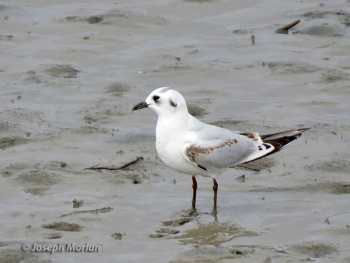- Saundersilarus saundersi
Chroicocephalus saundersi
Larus saundersi
Identification
Length 29–33 cm (11½-13 in); weight 170–220 g; wingspan 85–91 cm (33½-35¾ in).
Breeding adult
- Short black or blackish-red bill and black eye
- Full black head with conspicuous white eye lids
- Pale grey mantle and upperwing, with white trailing edge to secondaries, white outer two primaries with black subterminal marks on 2nd-5th primaries
- Underwing whitish, except for blackish-grey undersides to 3rd-5th primaries
- Body and tail white
- Dark red legs
Winter adult
- As breeding adult, but head white with a blackish smudge behind the eye.
First year
- Juvenile scaly brown above
- First-winter with pale grey mantle, narrow black terminal tail band, and patterned wing with black tips to secondaries, black tips and front edges of outer primaries, and brown patches on coverts. Bill and legs blackish.
Similar Species

Photo © by Joseph Morlan
Kagamimachinozaki Yatsushiro, Kumamoto Prefecture, Japan, 18 February 2019
Overall plumage pattern is very similar to Black-headed Gull and Bonaparte's Gull; from the former, differs in smaller overall size, shorter, black bill, black summer hood, and slightly less black on primary tips; from the latter (which is about the same size), differs in the stouter bill, and darker underwing pattern (more like Black-headed).
Distribution
Breeds around the coasts of the Yellow Sea in northeastern China and probably North Korea; formerly also bred in eastern South Korea. Winters on the eastern and southern coasts of China (including Hong Kong and Macao, southern Japan, South Korea, Taiwan, and Vietnam. Vagrant in southeasternmost Russia.
Taxonomy
This is a monotypic species[1]. Its generic placement is disputed; some authorities place it in its own genus Saundersilarus [1], while others place it in Chroicocephalus[2]. Like most other gulls, it was formerly included in Larus.
Habitat
Estuarine waters and intertidal marshes.
Status
Currently classified as Vulnerable in the IUCN Red List.3,4 Formerly classified as endangered, it continues to be threatened by habitat loss.
Behaviour
Reported to mix with Gull-billed Tern when feeding.
Breeding
All known colonies are in coastal salt-marshes, in areas dominated by Common Seepweed (Suaeda glauca). Usually lays three eggs in a shallow nest.
Diet
Little known but thought to be a specialist that exploits silt-laden waters especially rich in small crabs.
Movements
Birds move south and east off the coast of eastern China, and in winter recorded in North and South Korea and southern Japan south to northern Vietnam.
Vocalisation
Gives harsh, tern-like, calls kip and chao.
References
- Clements, J. F., T. S. Schulenberg, M. J. Iliff, D. Roberson, T. A. Fredericks, B. L. Sullivan, and C. L. Wood. 2018. The eBird/Clements checklist of birds of the world: v2018. Downloaded from http://www.birds.cornell.edu/clementschecklist/download/
- Gill, F & D Donsker (Eds). 2019. IOC World Bird List (v9.1). doi : 10.14344/IOC.ML.9.1. Available at http://www.worldbirdnames.org/
- BirdLife International (2019) Species factsheet: Saundersilarus saundersi. Downloaded from http://www.birdlife.org on 19/05/2019.
- BirdLife International 2018. Saundersilarus saundersi. The IUCN Red List of Threatened Species 2018: e.T22694436A132551327. http://dx.doi.org/10.2305/IUCN.UK.2018-2.RLTS.T22694436A132551327.en. Downloaded on 09 May 2019.
- Burger, J., Gochfeld, M., de Juana, E., Garcia, E.F.J. & Kirwan, G.M. (2019). Saunders's Gull (Saundersilarus saundersi). In: del Hoyo, J., Elliott, A., Sargatal, J., Christie, D.A. & de Juana, E. (eds.). Handbook of the Birds of the World Alive. Lynx Edicions, Barcelona. (retrieved from https://www.hbw.com/node/53998 on 10 May 2019).
Recommended Citation
- BirdForum Opus contributors. (2025) Saunders's Gull. In: BirdForum, the forum for wild birds and birding. Retrieved 15 May 2025 from https://www.birdforum.net/opus/Saunders%27s_Gull






